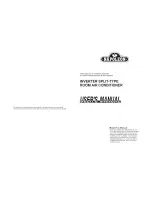
Troubleshooting
RT-SVX38C-EN
39
the previous section for the recommended
troubleshooting procedure.
Heating Failure
Verify heat failure by ignition module (IGN) LED indicator:
Cooling Failure
•
Cooling and heating set point (slide pot) on the zone
sensor has failed. Refer to the “Zone Sensor Test
Procedure” section.
•
Zone temperature thermistor ZTEMP on ZTS failed.
Refer to the “Zone Sensor Test Procedure” section.
•
CC1 or CC2 24 VAC control circuit has opened—check
CC1 and CC2 coils and any of the controls below that
apply to the unit (HPC1, HPC2).
•
LPC1 has opened during the 3-minute minimum “on
time” during 4 consecutive compressor starts—check
LPC1 or LPC2 by testing voltage between the J1-1 and
J3-2 terminals on the RTRM and ground. If 24 VAC is
present, the LPCs has not tripped. If no voltage is
present, LPCs has tripped.
Service Failure
•
If the supply fan proving switch has closed, the unit will
not operate (when connected to RTOM)—check the fan
motor, belts, and proving switch.
•
Clogged filter switch has closed—check the filters.
•
If the condensate overflow switch is closed, the unit
will not operate—check the float position is not in a
tripped condition and verify an “open” between wires
connecting to RTOM J6-1, J6-2 (ReliaTel™ controls).
Simultaneous Heat and Cool Failure
•
Emergency stop is activated
Method 2
The second method for determining system status is done
by checking voltage readings at the RTRM (J6). The
following sections list system indication descriptions and
the approximate voltages.
System Failure
•
Measure the voltage between terminals J6-9 and J6-6.
•
Normal operation = approximately 32 VDC
•
System failure = less than 1 VDC, approximately 0.75
VDC
•
Test mode = voltage alternates between 32 VDC and
0.75 VDC
Heat Failure
•
Measure the voltage between terminals J6-7 and J6-6.
•
Heat operating = approximately 32 VDC
•
Heat off = less than 1 VDC, approximately 0.75 VDC
•
Heating failure = voltage alternates between 32 VDC
and 0.75 VDC
Cool Failure
•
Measure the voltage between terminals J6-8 and J6-6.
•
Cool Operating = approximately 32 VDC
•
Cool Off = less than 1 VDC, approximately 0.75 VDC
•
Cooling Failure = voltage alternates between 32 VDC
and 0.75 VDC
Service Failure
•
Measure the voltage between terminals J6-10 and
J6-6.
•
Clogged filter = approximately 32 VDC.
•
Normal = less than 1 VDC, approximately 0.75 VDC
Fan Failure = voltage alternates between 32 VDC and
0.75 VDC.
To use LEDs for quick status information at the unit,
purchase a BAYSENS110* ZSM and connect wires with
alligator clamps to terminals 6 through 10. Connect each
respective terminal wire (6 through 10) from the Zone
Sensor to the unit J6 terminals 6 through 10.
Note:
If the system is equipped with a programmable
zone sensor, (BAYSENS119*, or BAYSENS023A),
the LED indicators will not function while the
BAYSENS110* is connected.
Resetting Cooling and Ignition Lockouts
Cooling failures and heating lockouts are reset in an
identical manner. Method 1 explains resetting the system
from the space; Method 2 explains resetting the system at
the unit.
Note:
Before resetting Cooling Failures and Ignition
Lockouts check the Failure Status Diagnostics by
the methods previously explained. Diagnostics will
be lost when the power to the unit is disconnected.
Resetting Lockouts—Method 1
To reset the system from the space, turn the “Mode”
selection switch at the zone sensor to the OFF position.
After approximately 30 seconds, turn the “Mode”
selection switch to the desired mode, e.g., Heat, Cool, or
Auto.
Off
No power or power failure
On
Normal
Slow flash Normal, heat call
Fast flash 1 flash
Communication failure
2 flashes
System lockout
3 flashes
Pressure switch fail
4 flashes
TC01 or TC02 open
5 flashes
Flame without gas valve
6 flashes
Flame rollout open
Summary of Contents for RT-SVX38C-EN
Page 26: ...Installation 26 RT SVX38C EN Figure 28 Examples...
Page 45: ......
Page 46: ......
Page 47: ......










































